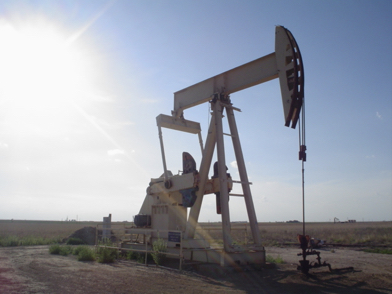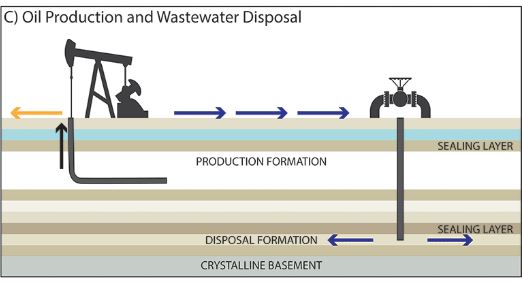– Aiming to make energy production safer, scientists developed a new model for forecasting earthquakes caused by oil and gas operations in the central U.S.
“The goal of this study is really to make energy production safer,” Shirzaei says. Having the tools to mitigate the seismic hazards associated with oil and gas production is important, he says.

Starting in 2009, the number of magnitude-3 and greater earthquakes occurring in the central U.S. sharply increased. Many of these earthquakes struck in Oklahoma, a region thought to be seismically quiet. By 2015, the number of magnitude-3-plus earthquakes was more than 40 times the average prior to this period. The cause of such an alarming jump in earthquake activity was oil and gas extraction operations—hydraulic fracturing, or fracking, and wastewater injection—in the region. Now, a team of scientists lead by Guang Zhai at Arizona State University has developed a model to forecast this earthquake activity so that energy companies can better manage operations to lessen the risk of damaging earthquakes.
How to make an earthquake
While vast majority of induced earthquakes the central U.S. are caused by fracking operations, they’re not caused by the fracking itself, but rather by disposal of wastewater used in these and other extraction operations.
Fracking techniques are used to reach difficult-to-access reserves of oil and natural gas. This process requires physically breaking apart rock at depth to release pockets of oil and gas trapped in tightly enclosed pore spaces. To break the rocks, a mixture of water, sand and chemicals is pumped beneath the surface, increasing pressure to the point where the rock fractures and the now-free oil and gas is collected. Some of this water is reused in future operations, but much of it is not. Traditional oil and gas extraction operations also produce saltwater as a byproduct. This water is often contaminated and cannot be used in other applications. All of these fluids require safe disposal.
Typically, these fluids are pumped back into the now-empty pore spaces in rock layers where oil and gas were previously extracted.

But evidence has emerged linking the injection of wastewater to the spike in earthquakes in the region [Ellsworth, 2013; Keranen et al., 2014]. Scientists discovered that the wastewater migrates over great distances through the rock units and sometimes reaches a fault. According to Manoochehr Shirzai, an associate professor at Arizona State University and a co-author of the new study, published in Proceedings of the National Academy of Sciences, this fluid acts to lubricate the fault, making it easier for it to slip, generating an earthquake. In addition, “fluids push the fault apart,” says Michael Manga, a professor of geology at the University of California, Berkeley, and co-author of the study. These fluids “create additional stress, and those additional stresses turn out to play an important role in making earthquakes,” Manga says.
Larger earthquakes pose a bigger problem
Most earthquakes, induced and natural, are typically small, undetectable by people and not large enough to cause damage. However, larger quakes can and do occur. In 2011, a magnitude-5.7 earthquake hit near Prague, Okla., causing minor damage. After the record-breaking number of quakes in 2015, operators turned down the dial on wastewater injection, hoping to reduce seismic hazard. The following year, three more magnitude-5-plus earthquakes occurred in the region. This highlights how fluids play a complex and lengthy role in generating earthquakes.
Forecasting induced earthquakes
In the new recent study, Manga, Shirzaei and colleagues developed a model for forecasting induced earthquakes. The model takes into account all of the physical processes that relate fluid injection to earthquake generation, a method the researchers call “physics-based.” According to Shirzaei, one of the benefits of this method is that the model can be applied anywhere, provided scientists know the geology and hydrology of an area well. To apply the model, it is critical to know how much pore space is present and how connected that pore space is.
Previous statistical forecast models relied on empirical relationships between wastewater injection and earthquakes in a specific region, making their application limited to that region. A physics-based model is also more realistic, Manga says.
The key parameters that differentiate this model are pore pressure and poroelastic stress, which describe the pressure of a fluid in the pore space in a rock and the stress that fluids place on that pore space. “Think about the earth like a kitchen sponge,” Shirzaei says. When you add water to the sponge, it flows into the pore space through a process called fluid diffusion. The water pushes on the walls of the sponge, which generates poroelastic stress, he says. This study is the first to demonstrate that the diffusion of pore pressure controls when induced earthquakes happen and how large they are.
With the new model, researchers can calculate the short-term probability of a medium to large earthquake for a given amount of wastewater that is injected into the ground. “We let the regulators and decision-makers decide if this probability is large enough for them to do anything,” says Shirzaei. This powerful tool gives operators a way of safely disposing of wastewater while lessening the risk of causing a damaging earthquake.
A tool for safer energy production
This is likely welcome information for wastewater injection operators everywhere. Having a tool to predict the effects of injection would “enable managers to be ahead of the game,” says Shirzaei. Workflows that include assessing earthquake risk give operators more control over the unintended effects of oil and gas production.
“The goal of this study is really to make energy production safer,” Shirzaei says. Having the tools to mitigate the seismic hazards associated with oil and gas production is important, he says.
By Jennifer Schmidt, Ph.D. (@DrJenGEO)

